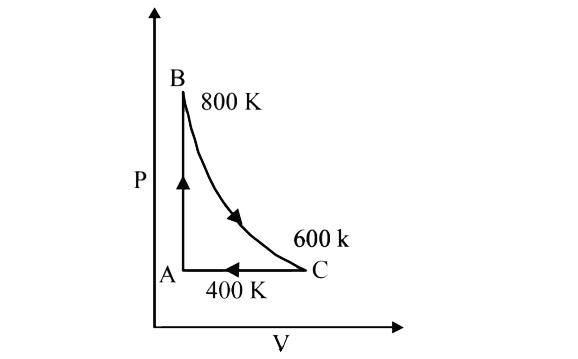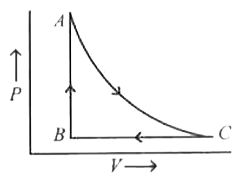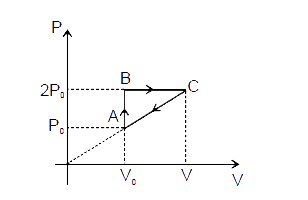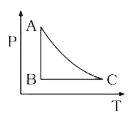One mole of a diatomic ideal gas undergoes a cyclic process ABC as shown in figure. The process BC is adiabatic. The temperature at A,B and C are 400K, 800K and 600K respectively. Choose the correct statement:

In process CA change in internal energy is 225R.
In process AB change in internal energy is −150R.
In process BC change in internal energy is −225R.
Change in internal energy during the whole cyclic process is +150R.
The correct Answer is:C
ΔUCA=nCV(TA−TC)
=1×32R×(300−450)=(−225R)
ΔUBC=nCv(TC−TB)
= 1×32R×(450−600)=−225R
ΔUABCA=ΔUCA+ΔUAB+ΔBC=0
Topper's Solved these Questions
- GEOMETRICAL OPTICSBook:ALLENChapter:GEOMETRICAL OPTICSExercise:EXERCISE -03
Explore 11 Videos
- GEOMETRICAL OPTICSBook:ALLENChapter:GEOMETRICAL OPTICSExercise:ASSERTION-REASON
Explore 40 Videos
- GEOMETRICAL OPTICSBook:ALLENChapter:GEOMETRICAL OPTICSExercise:EXERCISE -01
Explore 65 Videos
- CURRENT ELECTRICITYBook:ALLENChapter:CURRENT ELECTRICITYExercise:All Questions
Explore 427 Videos
- GRAVITATIONBook:ALLENChapter:GRAVITATIONExercise:EXERCISE 4
Explore 9 Videos
Similar Questions
Knowledge Check
One mole of ideal gas undergoes a cyclic process ACBA as shown in figure. Process AC is adiabatic. The temperatures at 1, B and C are 300 K,600 K and 450 K respectively. Choose the correct statement.
 AIn process CA, change in internal energy is 225 R.BIn process AB, change in internal energy is -150 RCIn process BC, change in intenal energy is -225 R.DChange in internal energy during the whole cyclic process is +150 R.
AIn process CA, change in internal energy is 225 R.BIn process AB, change in internal energy is -150 RCIn process BC, change in intenal energy is -225 R.DChange in internal energy during the whole cyclic process is +150 R.One mole of an ideal mono-atomic gas is taken round cyclic process ABCD as shown in figure below. Calculate
 AThe work done by the gas.BThe heat rejected by the gas in the path CAand the heat absorbed by the gas in the path AB.CThe net heat absorbed by the gas in the path BC.DThe maixmum temperature attained by the gas during the cycle.
AThe work done by the gas.BThe heat rejected by the gas in the path CAand the heat absorbed by the gas in the path AB.CThe net heat absorbed by the gas in the path BC.DThe maixmum temperature attained by the gas during the cycle.One mole of a monatomic ideal gas undergoes a cyclic process as shown in the figure (where V is the volume and T is the temperature). Which of the statements below is (are) true?
 AProcess I is an isochoric processBIn process II, gas absorbs heatCIn process IV, gas releases heatDProcesses I and III are not isobaric
AProcess I is an isochoric processBIn process II, gas absorbs heatCIn process IV, gas releases heatDProcesses I and III are not isobaric
n moles of a diatomic gas has undergone a cyclic process ABC as shown in figure. Temperature at A is T0. Find
 Total heat given to gas ?
Total heat given to gas ?
View Solutionn moles of a diatomic gas has undergone a cyclic process ABC as shown in figure. Temperature at A is T0. Find

Find out the efficiency
View SolutionTwo moles of a monatomic ideal gas undergo a cyclic process ABCDA as shown in figure. BCD is a semicircle. Find the efficiency of the cycle.

View SolutionAn ideal gas undergoes a cyclic process as shown in the given P-T diagram, where AC is adiabatic. The process is also represented by:

View SolutionA gas undergoes a cyclic process ABCDA as shown in the figure. The part ABC of process is semicircular. The work done by the gas is

View Solution



